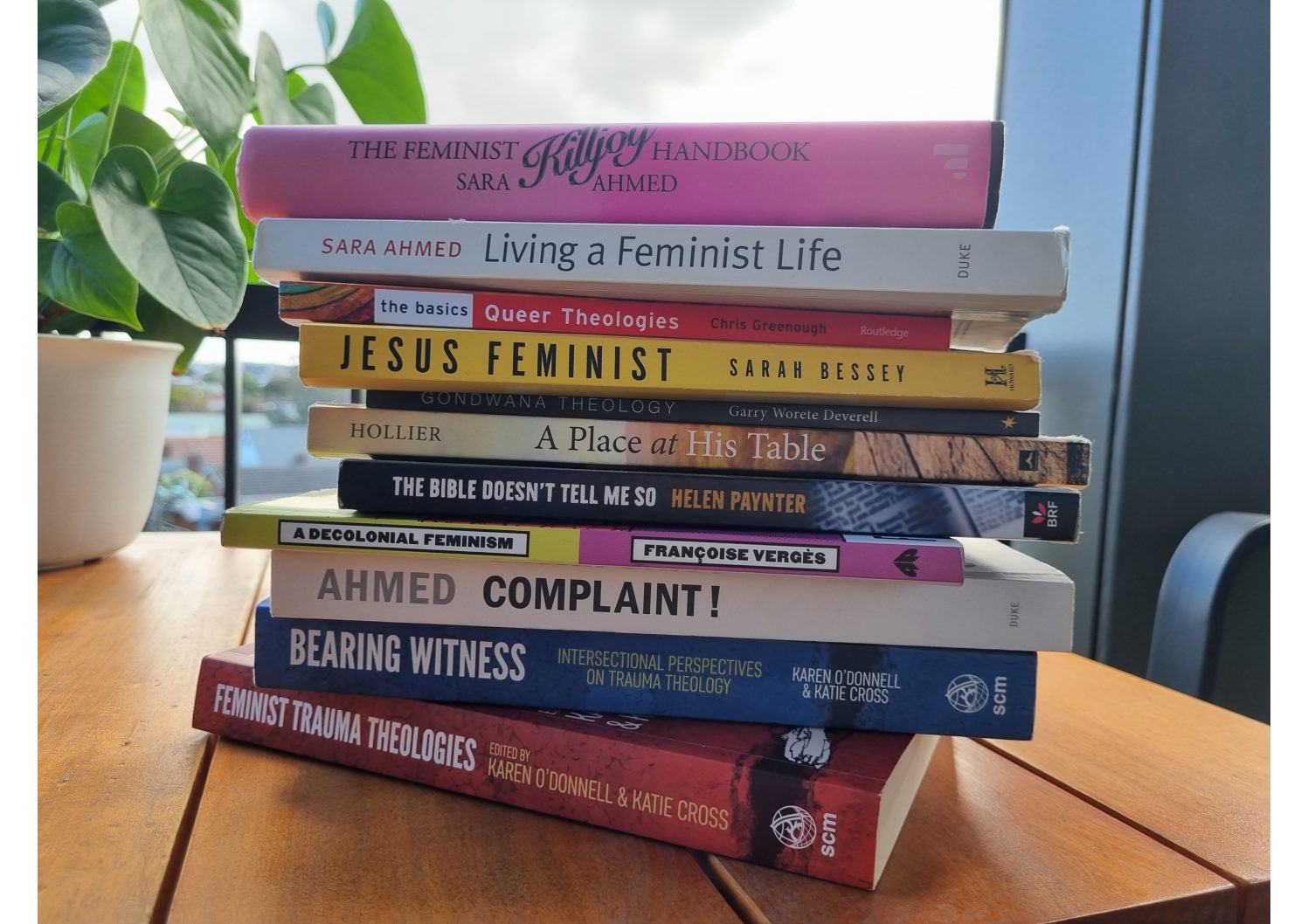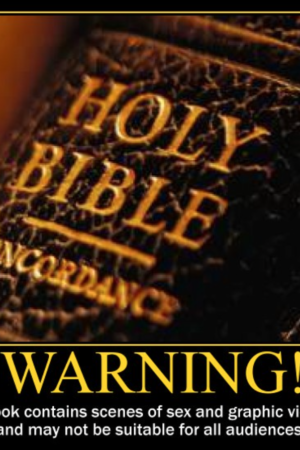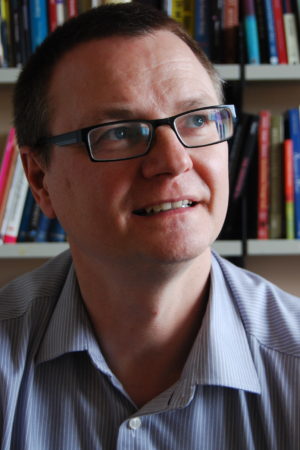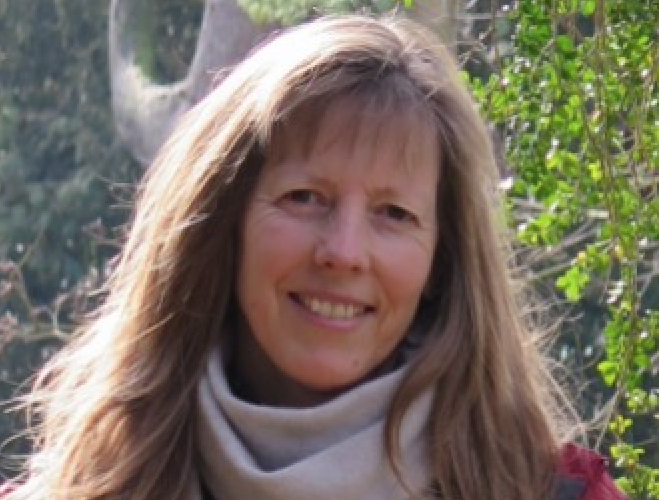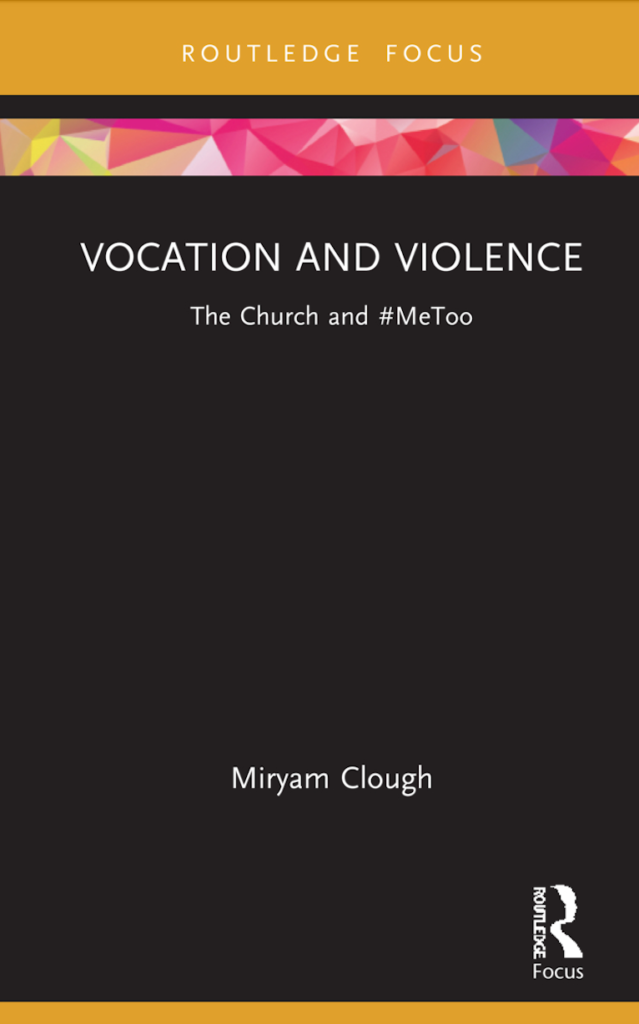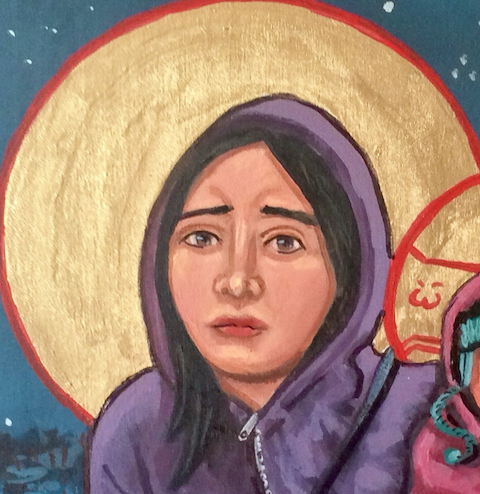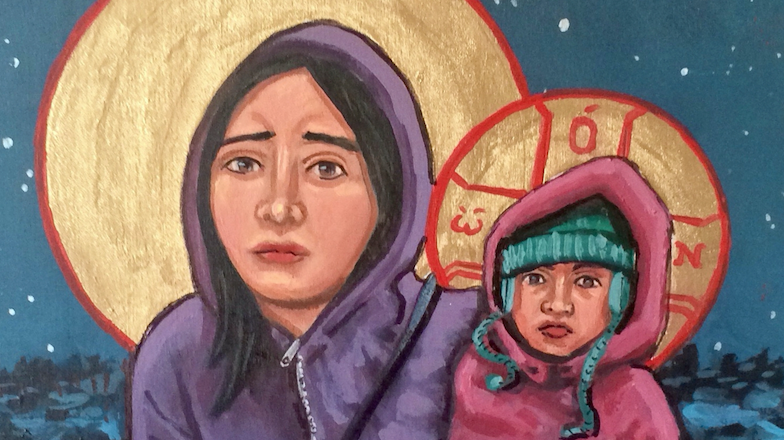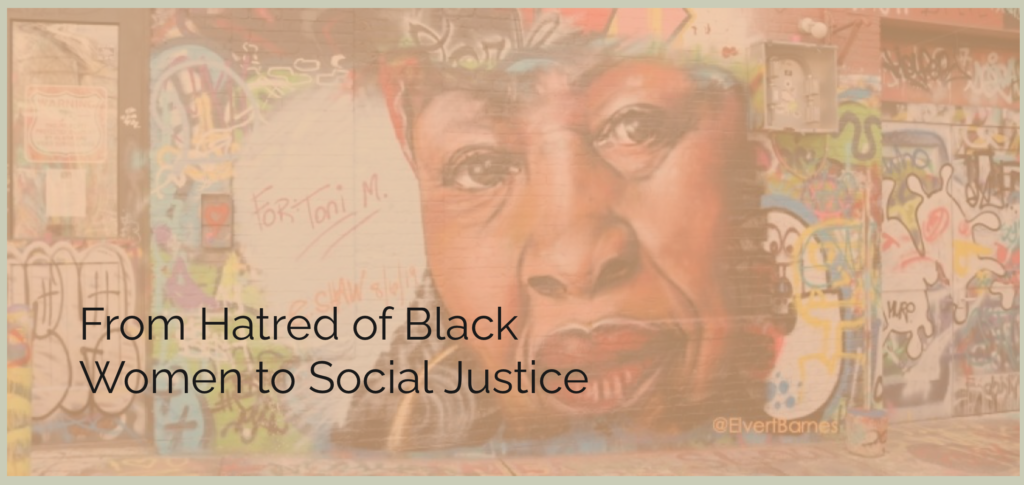Today’s post is by Alexiana Fry. Alexiana is a recent Hebrew Bible/Old Testament PhD graduate of Stellenbosch University. Her dissertation is on the sin of Gibeah, focusing on Judges 19 alongside Hosea through the lenses of trauma, migration, and feminism. She is currently working on her first book, under contract with Lexington Press, which explores the intersections of speech act theory and trauma hermeneutics.
When not reading or writing, you can find Alexiana playing with her two pugs, or on Twitter: @alexianadlou
Today’s post looks at three biblical women characters on the margins (or are they?) of eventful stories of invasion and war. Each of these stories is violent; in each of these stories a woman is in danger. But is a straight-out rejection of such stories helpful? Is there another way to read and learn from them?

Margin. Meeting. Mirror.
Rahab in Joshua 2-6, the nameless Levite’s wife in Judges 19, the necromancer of En-Dor in 1 Samuel 28: all three characters have things in common. All of them feature in stories of hospitality and violence. All are considered “other” – inhabiting marginalized places. Each of these women’s bodies constitutes a “meeting place” for men.
But maybe the biblical author is also through these women stating something rather subversive and calling on us to read responsibly. In what follows, I attempt to read these women for “the dignity of all” and in so doing, seek the God within these stories.
Introduction
I grew up in a white, evangelical church and heard almost no biblical stories in which women played anything other than supporting roles at best. I remember a cute, PG version of Esther,[1] done as a musical play and put on by the children in my church–but that rendition, with Esther in the starring role, was an exception. Biblical women and actual women were mostly on the sidelines. Hence, women were mostly relegated to roles in the home and abstained from anything that could be interpreted as asserting themselves over against the dominance that was “rightfully” men’s. This, inevitably, erased girls’ and women’s visible presence and representation.
Rebecca Solnit, in her memoir Recollections of My Non-Existence, says this about her love for literature, and about lack of representation and its effects:
“You should be yourself some of the time. You should be with people who are like you, who are facing what you’re facing, who dream your dreams and fight your battles, who recognize you. And then, other times, you should be like people unlike yourself. Because there is a problem as well with those who spend too little time being anyone else; it stunts the imagination in which empathy takes root, that empathy that is a capacity to shape-shift and roam out of your sole self. One of the convenient afflictions of power is a lack of this imaginative extension. For many men it begins in early childhood, with almost exclusively being given stories with male protagonists… And the task of finding one’s own way must be immeasurably harder when all the heroes, all the protagonists, are not only another gender but another race, or another sexual orientation, and when you find that you yourself are described as the savages or the servants or the people who don’t matter. There are so many forms of annihilation.”[2]
In pursuit of representations of women in the Hebrew Bible, I notice patterns in some of the stories of my foremothers. I look closely at Rahab, at the Levite’s nameless wife, and at the necromancer at En-Dor. Each depiction is riddled with and even defined by problematic binaries, yet those binaries are also confronted and refuted by the women themselves. In each story, we see borne out what Solnit says: “there are so many forms of annihilation.” But I also see God herself speaking through and imaged in these women.[3] Let me explain this tension.
Margins
The women in these stories are located at the margins—both socially and spatially/geographically. Rahab initially resides in the town of Jericho, one of the first cities in Canaan encroached on by the Israelites as they leave the wilderness. Rahab is “foreign” in relation to the Israelite normative, indigenous to the land that is being stolen. She is a sex worker by occupation, and a woman. Even when she is spared by and joins the invaders, she remains at the outer margin of their encampment (Jos. 6:23).
The nameless Levite’s wife is rendered marginal by the lack of a name and by her designation as a pilegesh, probably a secondary wife (although this word is still debated in scholarship). Some scholars propose she is little more than a sex-toy to the Levite.[4] There is no mention of another wife, primary or otherwise, and no mention of children. Being from Bethlehem, she is an outsider to those of Gibeah or Ephraim. She is, again, a woman. Following her brutal and sustained abuse, her hands reach for the threshold—the liminal, or transitional, space at the border between private and public spheres—showing starkly that neither space, to either side, is safe for her.
The necromancer (or diviner) resides in En-Dor, which is possibly another marginal location, a town on a border. This place of residence may be significant: only here can she perform her illegal (though highly effective, apparently) occupation of divining. She may belong to a persecuted guild, or ancestor-worshipping religion, and may have to be ready to move at short notice across borders. While, seemingly, well known for her excellent divining, she, too, is nameless, and again, a woman.
These three women, consequently, in a number of ways all exist at intersection(s), or rather, at borderlands.
Namelessness can convey precarity. Rahab has a name; the other two women discussed here have not. In the Judges 19 story in particular, namelessness is much discussed; after all, all the characters in Judges 19 are nameless. For Laura Smit and Stephen Fowl namelessness here holds theological significance. They argue that anonymity in this chapter signifies one way to show how far the characters have “fallen from God”: “the loss of a name is a symptom of the slide backward from the creation into which we have been called toward nonbeing.”[5] J. Cheryl Exum argues that the concubine’s anonymity, “encourages readers not to view her as a person in her own right.”[6] Another way to view the story is, like Adele Reinhartz, to see nameless characters of the Hebrew Bible as becoming “types.” In one sense, types are non-specific, but in another, they are representative of the general thing they are designated as: thus, in the story of Judges 19 each of Levite, pilegesh, servant, old man, father, virgin daughter, men of wickedness represents, if not a specific individual, this named category.[7]
In this way, anonymity can be seen to be given a greater place, because it fulfils a rhetorical function and a “universalizing purpose.”[8] Havilah Dharamraj gives an example of how this can be implemented in a reading that emphasizes anonymity as type: “the narrator seems to be saying that every Levite was capable of the horrendous acts described. Every host was potentially helpless against the mistreatment of his guests, and every woman could become a victim of rape until death.”[9]
Similarly, Mieke Bal suggests that:
“The powerlessness of the victims [in Judges (the nameless wives of the Levite and Samson and Jephthah’s daughter),] is the first element of the counter coherence. It is not a mindless subordination. All three young women show, at some point of their stories, some autonomy of action. It is not a lack of initiative or capacity that condemns them, but the ‘might’ of the men, the gibborim, who are socially entitled to exercise power over them. The powerlessness of their situation is reflected on the literary level by their namelessness.”[10]
In some ways, too, the namelessness of both the Levite’s wife and the necromancer of En-Dor leaves us as readers denied of, as Rhiannon Graybill expresses it, “the experience of closure and catharsis.” Namelessness leaves us at a loss as to how to “rescue” or reclaim the women in these stories from what comes next. We may long to save or at least to remember these women and to prevent further marginalization, or silencing.[11] Their namelessness makes this harder.
Moving on from this topic, another commonality is that each of these stories is written from a male perspective, or suggests a male gaze. Male characters are at the center; masculine concerns (invasion, war) and actors drive the plot. The implied gaze is male and heteronormative. This, in turn, contributes to casting the female as “other” in these stories. It is striking that they still have any place in the sacred text at all! Moreover, in her story, Rahab is even granted survival and safety, though she and her family remain on the outside of the camp, not truly brought into the fold (Josh. 6:23). The story of the Levite’s nameless wife, however, ends in her violent dismemberment and dehumanization. While it seems that the necromancer gets a pass, the Chronicler later attributes the fault and fall of Saul to his action of seeking out a medium. In so doing, the narrator blames the woman (1 Chron. 10:13). Not only are the female characters marginalized and harmed in a multitude of ways in the story world; they are also, to use J. Cheryl Exum’s expression, “raped by the pen”: that is, the very way the narrative is constructed violates the female characters.
One weapon widely used in these stories to violate the literarily marginalized women is stereotyping. Stereotyping a person or character makes it easier to depersonalize and to dismiss them. Johnny Miles, who writes on the concept of othering both in the context of ancient Israel and in the contemporary United States, says this in conversation with Michael Pickering:
“stereotyping is more rigid and inflexible when thinking in terms of categories, and the evaluative ordering produced by stereotyping comes at a cost for those stereotyped who ‘are then fixed into a marginal position or subordinate status and judged accordingly.’ Though often found to be erroneous, simplistic, and rigid, stereotypes nonetheless perform their damage discriminating on the basis of stunted features characterizing them, and they ‘form the basis for negative or hostile judgments, the rationale for exploitative, unjust treatment, or the justification for aggressive behavior.’”[12]
Aggressive behavior often follows when stereotypes are weaponized. Sometimes stereotyping serves to excuse such aggression. Labeling certain women as “witches” and using the label to justify their ill-treatment, is a gendered stereotype. Notably, the necromancer at En-Dor is in some translations called a “witch.” Kimberly Stratton points out how in times past “witch-hunting constituted the hunting of women who refused to conform to societal expectations about proper (submissive) female behavior.”[13] There are other pervasive stereotypes that follow and harm women right up to the present: like those pertaining to sex-workers, migrants, and women of color, who are all disproportionately targeted by physical aggression and sexual violence. It would be remiss not to mention the stereotypes that haunt those in the Hebrew Bible called zonah, widely translated “prostitute” or “harlot” in English bibles. Zonah, sometimes denoting a sex worker, also refers sometimes to “playing the whore,” or “unfaithfulness,” especially with reference to idolatry. While Rahab may be deemed a “good” sex worker, including by those who consider themselves objective interpreters of the biblical text, the affect many readers first assume when reading of her profession is disapproval, even the judgment that this woman deserves what is about to befall the city of Jericho. An action from the same semantic root as zonah is also attributed to the Levite’s wife in Judges 19:2 and this is sometimes pointed to as justification for her gang-rape and dismemberment. In other words, her performance of zonah is interpreted as a crime befitting severe and sadistic punishment. This is disturbing and dangerous.
Meetings
Not only are all three women at intersections, but each operates as a bridge of sorts, as a meeting place for the men in the story. The women work specifically as conduits, in order for the men to progress to the next place in their privileged his-stories. The women’s bodies become primarily functional, even as they lay claim to agency and voice.
Rahab is the meeting point for the spies and a conduit between resident Canaanites and invading Israelites. She fits in the category of the model minority, or the exception to the rule, in that she aids the “right” side, in spite of belonging to the “wrong” people. She also does sex work, which might compromise her “right”-ness. It is a matter of debate whether Rahab was sought out for the work she does. Did the spies encounter Rahab because they were seeking sex? Seemingly, activities designated זנה (z-n-h) bring less condemnation to the men who seek sex work than to the persons (usually women) who perform it. Words from this root are repeated multiple times and make Rahab’s sex work her prominent characteristic. Is Rahab opportunistically grasping at anything that allows her and her family to survive? Who can blame her? Because Rahab concedes to the invaders’ notions and beliefs about conquest and domination (which is hardly a choice or option for her), she is saved.
The Levite’s nameless wife is the meeting place for multiple men. She connects the Levite and her father; later, she is seized and thrown out from the house in Gibeah to the wicked men to save the men inside; finally, her dismembered body is the call to war that brings the men of the tribes of Israel together.
The necromancer of En-Dor is persecuted for her profession. Yet she becomes the meeting point and medium enabling communication and encounter between YHWH, King Saul, and the dead prophet (or rather, “god”) Samuel. The men in each of these stories reach a precarious spot and, regardless of the cost and risk befalling them, use women to escape danger.
Rahab holds the power over the spies’ lives, as well as over the lives of the members of her community. Her actions save her life and the lives of members of her immediate family, but then she quickly relinquishes agency once more. The Levite’s wife starts the story with considerable agency, leaving the Levite. As the story continues, the Levite’s power grows, and her agency diminishes. Every male in her story completely and utterly fails her. In death, however, her body still has the power to bring together tribes for war. The necromancer of En-Dor has the power to raise the dead but her role is short-lived and she recedes again to the margins from which she, briefly, emerged.
Being the meeting place and conduit for men, the women in these stories, while not devoid of agency, are, above all, acted upon. While each finds herself in the borderlands, their bodies act as bridges. Susan Niditch writes of Judges 19, “the tale as told also emphasizes the ways in which women, the mediating gender, provide doorways in and out of war.”[14] Beyond the lens of private and public spheres and the gendered roles assigned them, the in-between nature of the three women renders them dispensable following their use for men’s advancement. In each story, the power these women have is recognized by the men, used instrumentally, and, once they have been used as a bridge from a dangerous place and to garner more power, the women all fade from the story.
Gloria Anzaldúa writes as a woman caught in the crossroads: “blocked, immobilized, we can’t move forward, can’t move backwards.”[15] Anzaldúa writes this from her perspective as someone on the margins in terms of her sexuality, race, and gender. She remarks on the desire of others to find her on one or other side of dichotomies; but these dichotomies are disrupted in her existence. She writes in a poem, “you are the battleground”[16] and this speaks also to the three biblical women who are my focus here.
The notion of a battleground becomes actual in all three stories. In Rahab’s story, the Israelites invade; in Judges 19, the brutal rape and killing transpire in more war; in the story of the necromancer battle soon ensues. And maybe, as Graybill writes, “we should stay with this trouble.”[17] Maybe we should linger with the stories’ unknowns, complexities, and difficulties. Consequently, I am not advocating a rewriting, or an attempt to make these passages more acceptable to our tastes or liking. Instead, maybe there is a piece (and peace) where we can feel the affect and how it acts upon us, the reader. Maybe, too, if we linger, the deity, also at the margins in these stories, can be found where one wasn’t looking for her.
Mirrors
Isabelle Hamley writes that, “women work as the fixed reference points, the mirrors of male constructions of subjectivity. As such, they cannot have their own representations, discourse, or desires, as this would threaten male totalitarian constructs.”[18] And, as has been demonstrated, each of the women in these stories functions in a situation of threat, and helps men through a situation of threat. Mirroring also entails negative space, projection, and a “reverse image,” or inverse reflection. Analogously, even as the text is a product of the male elite of the time, is there still yet a way to re-imag(in)e without rewriting, to “refuse salvation” as Graybill puts it?[19] Can the mirroring that occurs in these texts function also to capture a glimpse of the deity, mirrored in these women’s bodies?
Yes, the texts can be seen and interpreted in ways that reflect and serve the status quo but maybe they can (and should) also be interpreted in other, even subversive ways. Jeremiah Cataldo writes, “in facing the Other we are judged by her, called into an ethical relationship by her.”[20] Confrontation with the Other can incite critique of the very power structures that are held up and reflected in the narratives. Might such confrontation also change behaviors, so that the future and upcoming “afters” might be different? There may not be repair in these stories, even if YHWH is mirrored therein, but they might hold a mirror up to our own time and bring repair long after they were written and first transmitted.
While stereotypes and binaries in these stories have contributed to some interpreters placing criticism and blame on the women – Rahab, the Levite’s wife, the necromancer – the texts can also point to other, restorative, readings. God can be imaged into each of these women. Each woman holds something that signifies divine knowledge. Rahab gives what some call a testimony or even “conversion” (Josh. 2:9-13); the necromancer is herself a skilled prophet who successfully conjures up Samuel (literally “god”); the Levite’s wife with her body bears witness and demands justice. In each story, it could be said, YHWH sides with the Other, with the women. Fault lies with the spies, Joshua and Canaanites, with Saul, with the wicked men of Gibeah, and the Levite. The usual binaries do not hold up, the women refuse to fit neatly inside them; binaries disintegrate. As Anzaldúa writes of crossroads that break down dualities: answers are equivocal, found in the between spaces, by “a conscious rupture with all oppressive traditions of all cultures and religions, communicating that rupture, documenting the struggle.”[21]
This account of mine has itself moved from sensation to perception, from margin to meeting. But both of these must be moved through, into a place where we can receive the Other. As Hamley writes, “when one voice has sought to dominate and tell the whole from the point of view of the One, then deconstruction—but not destruction—is needed.”[22] The aim and of this piece, similarly, has been not destruction of difficult and violent texts but deconstruction and a willingness to meet, reflect and mirror.
Conclusion
The personal is indeed political. My attempt at personal encounter with the women in these stories – imagining them as embodied, seeking their affect and mirror image – has proven political. Judith Butler, writing on whose lives are mournable in the face of violence, states that,
“when we consider the ordinary ways that we think about humanization and dehumanization, we find the assumption that those who gain representation, especially self-representation, have a better chance of being humanized, and those who have no chance to represent themselves run a greater risk of being treated as less than human, regarded as less than human, or indeed, not regarded at all.”[23]
Butler alerts us to resisting stereotypes and dehumanization. Similarly, Cataldo calls us to the performative responsibility of acknowledging the Other. As biblical scholars, we have a choice, indeed a responsibility, to read for liberation, and to refuse to read the marginalized as flattened, dispensable objects. Because, as Miles writes, “stories of the past become in actuality reflections of the present,”[24] responsibility is our duty. As the proverbial saying goes, “may the bridges we burn light the way.”
Bibliography
Anzaldúa, Gloria. Borderlands/La Frontera: The New Mestiza. San Francisco: Aunt Lute, 1987.
Bal, Mieke. Death and Dissymmetry: The Politics of Coherence in the Book of Judges. Chicago, IL: University of Chicago Press, 1988.
Butler, Judith. Precarious Life: The Powers of Mourning and Violence. New York: Verso, 2004.
Cataldo, Jeremiah. “The Other: Sociological Perspectives in a Postcolonial Age.” Imagining the Other and Constructing Israelite Identity in the Early Second Temple Period. Ehud Ben Zvi and Diana Edelman eds. New York: Bloomsbury, 2016.
Dharamraj, Havilah. “Judges,” in South Asia Bible Commentary: A One-Volume Commentary on the Whole Bible. Grand Rapids, MI: Zondervan, 2015, 296-334.
Exum, J. Cheryl. Fragmented Women: Feminist (Sub)Versions of Biblical Narratives. New York: T&T Clark, 2015.
Graybill, Rhiannon. Texts After Terror: Rape, Sexual Violence, and the Hebrew Bible. London: Oxford University Press, 2021.
Hamley, Isabelle M. Unspeakable Things Unspoken: An Irigarayan Reading of Otherness and Victimization in Judges 19-21. Eugene, OR: Pickwick Publications, 2019.
Klein, Lillian R. The Triumph of Irony in the Book of Judges. Sheffield: Sheffield Academic Press, 1988.
Miles, Johnny. Constructing the Other in Ancient Israel and the USA. The Bible and Modern World, 32. Sheffield: Sheffield Phoenix Press, 2011.
Niditch, Susan. Judges: A Commentary. Old Testament Library. Louisville: Westminster John Knox, 2008.
Paynter, Helen. Telling Terror in Judges 19: Rape and Reparation for the Levite’s Wife. London: Routledge, 2020.
Pickering, Michael. Stereotyping: The Politics of Representation. New York: Palgrave MacMillan, 2001.
Reinhartz, Adele. ‘Why Ask My Name?’: Anonymity and Identity in Biblical Narrative. Oxford: Oxford University Press, 1998.
Smit, Laura and Stephen Fowl. Judges & Ruth. Brazos Theological Commentary on the Bible. Grand Rapids: Baker Publishing, 2018.
Solnit, Rebecca. Recollections of My Non-Existence. New York: Penguin Books, 2021.
Stratton, Kimberly and Dayna Kalleres, eds. Daughters of Hecate: Women and Magic in the Ancient World. Oxford: Oxford University Press, 2014.
[1] For a non-PG reading of Esther, see the recent publication by Ericka Dunbar. For more information, see here.
[2] See Solnit (2020: 110-113).
[3] This includes those who identify as women. Taking a lead from trans activists, I move away from “womxn,” because trans women are women: full stop.
[4] This is taken from Lillian R. Klein: “Given these conditions, the Levite seems to have brought the girl for purposes of sexual gratification or housekeeping (or both), possibly because he could not afford the bride price of a wife. The narrative supports this conjecture: the Levite pretends to be more affluent than he really is; and although he pursues his concubine to bring her back, he ignores her in every respect but one: in presenting her to the Gibeaites for abuse, he acknowledges her as a sexual object” (1988: 162-63).
[5] Smit and Fowl (2018: 180).
[6] Exum (2015: 176).
[7] Reinhartz (1998: 6).
[8] Paynter (2020: 32). See more information, here.
[9] Dharamraj (2015: 325).
[10] Bal (1988: 23).
[11] Graybill (2021: 168-69).
[12] Miles (2011) and Pickering (2001: 31).
[13] Stratton (2014: 9).
[14] Niditch (2008: 193).
[15] Anzaldúa (1987: 43).
[16] Ibid. (1987: 52-53, 216).
[17] Graybill (2021: 168).
[18] Hamley (2019: 10).
[19] Graybill (2021: 169).
[20] Cataldo (2016: 19).
[21] Anzaldúa (1987: 103-04).
[22] Hamley (2019: 25).
[23] Butler (2006: 141).
[24] Miles, (2011: 44).


